Evaluating the Performance of Class F Fly Ash Compared to Class G Cement for Hydrocarbon Wells Cementing: An Experimental Investigation
Abstract
1. Introduction
2. Experimental Description
2.1. Experiments Methodology
2.2. Experiment Material
- Fly Ash (SiO2 + Al2O3 + Fe2O3): This experiment consists of Class F Fly Ash; as such, the fly ash being used mainly consists of silica, alumina, iron oxide, and a low lime/calcium and content.
- Sodium Metasilicate (Na2SiO3): Sodium metasilicate is the solid and more concentrated form of liquid sodium silicate. This concentration provides a strong alkaline activation of the silicates in the fly ash.
- API Class G Cement: The cement used in this experiment is API Class G cement, the most commonly used cement type in completing the construction of oil and gas wells. This material mainly consists of high lime and silica content, as well as iron oxide and alumina.
- Water: The water used for this experiment was at room temperature tap water. This water was used to mix the different cements.
2.3. Geopolymer Formulation and Procedure
2.3.1. Geopolymer Initial Formulation Calculations
2.3.2. Geopolymer Mixing Procedure
2.3.3. Optimization of Geopolymer Samples
2.4. Cement Formulation and Procedure
2.4.1. Cement Formulation Calculations
2.4.2. Class G Cement Material and Mixing Procedure
2.5. Experimental Scope
2.5.1. Fluid Loss Test Procedure
2.5.2. Thickening Time Test Procedure
3. Results and Discussion
3.1. Geopolymer Slurry Setting
3.2. Cement Slurry Setting
3.3. Fluid Loss Test
3.4. Thickening Time Test
4. Conclusions
- There is an inconsistency in the alumina/silica content as well as CaO composition with fly ash batches from different origins, and this results in inconsistent reactions.
- Though Class F fly ash geopolymers are said by researchers to accelerate more than Class G cement in setting, it was found to differ depending on the batch; furthermore, Class G cement thickened at high temperatures and pressures faster than the geopolymer with a high consistency.
- Class G cement showed a more consistent fluid loss with the increase of temperature and pressure than Class F fly ash and can have additives to improve its integrity.
- Class G cement can be used for water, oil, and synthetic-based drilling fluids, whereas there is little known research of using Class F fly ash with drilling fluids.
- Sodium metasilicate and sodium hydroxide are required for the alkaline activator that the geopolymer needs to have both a strong and balancing aluminosilicate gel that gets stronger with time, water exposure, and temperature.
- Additives such as extenders, retarders, thickeners, dispensers, and more can be added to the cement to have it react in a function according to the cement design and purpose of the operation.
Author Contributions
Funding
Institutional Review Board Statement
Informed Consent Statement
Data Availability Statement
Acknowledgments
Conflicts of Interest
References
- Suppiah, R.R.; Abd Rahman, S.H.; Irawan, S.; Shafiq, N. Development of New Formulation of Geopolymer Cement for Oil Well Cementing. In Proceedings of the International Petroleum Technology Conference, Bangkok, Thailand, 14–16 November 2016. [Google Scholar]
- Manager, A. Oil Well Cementing Functions, Classes and Equipment. Available online: http://www.arab-oil-naturalgas.com/oil-well-cementing-functions-classes-and-equipment/ (accessed on 23 February 2024).
- Market Data Centre. Ready Mix Concrete Market to Reach USD 1404.2 billion by 2030, Growing at a Cagr of 8.5%: MDC Research. Available online: https://www.globenewswire.com/en/news-release/2022/06/01/2454316/0/en/Ready-Mix-Concrete-Market-to-reach-USD-1404-2-billion-by-2030-growing-at-a-CAGR-of-8-5-MDC-Research.html (accessed on 23 February 2024).
- Ahdaya, M.S.; Imqam, A.; Jani, P.; Fakher, S.; ElGawady, M. New Formulation of Fly Ash Class C Based Geopolymer for Oil Well Cementing. In Proceedings of the International Petroleum Technology Conference, Beijing, China, 26–28 March 2019. [Google Scholar]
- Hemalatha, T.; Ramaswamy, A. Fly Ash Cement. In Handbook of Fly Ash; Elsevier: Oxford, UK, 2022; pp. 547–563. [Google Scholar]
- Hájek, M.; Decký, M.; Scherfel, W. Objectification of Modulus Elasticity of Foam Concrete Poroflow 17-5 on the Subbase Layer. Civ. Environ. Eng. 2016, 12, 55–62. [Google Scholar] [CrossRef]
- Crook, R. Chapter 9—Cementing. In Petroleum Engineering Handbook; Drilling Engineering; Society of Petroleum Engineers: Richardson, TX, USA, 2006; Volume 2, pp. 369–431. [Google Scholar]
- Fly Ash—Properties, Types, Mechanism and Uses. Available online: https://theconstructor.org/building/fly-ash-properties-types-mechanism/26654/ (accessed on 23 February 2024).
- Parliament of India. Specification for Pulverized Fuel Ash, Part 1. Available online: https://law.resource.org/pub/in/bis/S03/is.3812.1.2013.pdf (accessed on 23 February 2024).
- Fly Ash Facts for Highway Engineers. Available online: https://www.fhwa.dot.gov/pavement/recycling/fafacts.pdf (accessed on 23 February 2024).
- Standard Specification for Coal Fly Ash and Raw or Calcined Natural Pozzolan for Use in Concrete. Available online: https://www.astm.org/c0618-12.html (accessed on 23 February 2024).
- Fly Ash—Properties, Source, Advantages, Uses. Available online: https://daswell.com/blog/learn-about-fly-ash/ (accessed on 23 February 2024).
- Singh, N.B. Fly Ash-Based Geopolymer Binder: A Future Construction Material. Minerals 2018, 8, 299. [Google Scholar] [CrossRef]
- Sugumaran, M. Study on Effect of Low Calcium Fly Ash on Geopolymer Cement for Oil Well Cementing. In Proceedings of the SPE/IATMI Asia Pacific Oil & Gas Conference and Exhibition, Nusa Dua, Bali, Indonesia, 20–22 October 2015. [Google Scholar]
- Nasvi, M.; Ranjith, P.G.; Sanjayan, J. Mechanical Properties of Geopolymer Cement in Brine: Its Suitability as Well Cement for Geological Sequestration of Carbon Dioxide (CO2). In Proceedings of the ISRM Regional Symposium—7th Asian Rock Mechanics Symposium, Seoul, Republic of Korea, 15–19 October 2012. [Google Scholar]
- Zain, H.; Abdullah, M.M.; Hussin, K.; Ariffin, N.; Bayuaji, R. Review on Various Types of Geopolymer Materials with the Environmental Impact Assessment. MATEC Web Conf. 2017, 97, 01021. [Google Scholar] [CrossRef]
- Why Use Fly Ash and Slag in Concrete?—Bay-Lynx Manufacturing Inc. Available online: https://bay-lynx.com/education/why-use-fly-ash-and-slag-in-concrete/ (accessed on 23 February 2024).
- Class C Fly Ash, Penn State University. Available online: https://www.engr.psu.edu/ce/courses/ce584/concrete/library/materials/Altmaterials/Class%20C%20Fly%20Ash.htm (accessed on 23 February 2024).
- Yu, J.; Chen, Y.; Chen, G.; Wang, L. Experimental Study of the Feasibility of Using Anhydrous Sodium Metasilicate as a Geopolymer Activator for Soil Stabilization. Eng. Geol. 2020, 264, 105316. [Google Scholar] [CrossRef]
- Haruna, S.; Mohammed, B.S.; Wahab, M.M.; Kankia, M.U.; Amran, M.; Gora, A.M. Long-Term Strength Development of Fly Ash-Based One-Part Alkali-Activated Binders. Materials 2021, 14, 4160. [Google Scholar] [CrossRef] [PubMed]
- Ahdaya, M.; Imqam, A. Investigating Geopolymer Cement Performance in Presence of Water Based Drilling Fluid. J. Pet. Sci. Eng. 2019, 176, 934–942. [Google Scholar] [CrossRef]
- Kanesan, D.; Chandran, D.; Bin Azhar, N.A. Contamination Effect of Synthetic Based Mud on Fly Ash Based Geopolymer Cement Slurry. ARPN J. Eng. Appl. Sci. 2019, 14, 1871–1875. [Google Scholar]
- Adjei, S.; Elkatatny, S.; Aggrey, W.N.; Abdelraouf, Y. Geopolymer as the Future Oil-Well Cement: A Review. J. Pet. Sci. Eng. 2022, 208, 109485. [Google Scholar] [CrossRef]
- Salehi, S.; Khattak, J.; Saleh, F.K.; Igbojekwe, S. Investigation of Mix Design and Properties of Geopolymers for Application as Wellbore Cement. J. Pet. Sci. Eng. 2019, 178, 133–139. [Google Scholar] [CrossRef]
- Salehi, S.; Khattak, M.J.; Ali, N.; Ezeakacha, C.; Saleh, F.K. Study and Use of Geopolymer Mixtures for Oil and Gas Well Cementing Applications. J. Energy Resour. Technol. 2017, 140, 012908. [Google Scholar] [CrossRef]
- Abdelaal, A.; Elkatatny, S.; Abd El Fattah, A.M. Development of Heavy-Weight Hematite-Based Geopolymers for Oil and Gas Well Cementing. ACS Omega 2023, 8, 14025–14033. [Google Scholar] [CrossRef] [PubMed]
- API Specification 10, Specification for Materials and Testing for Well Cements; American Petroleum Institute: Washington, DC, USA, June 2011.
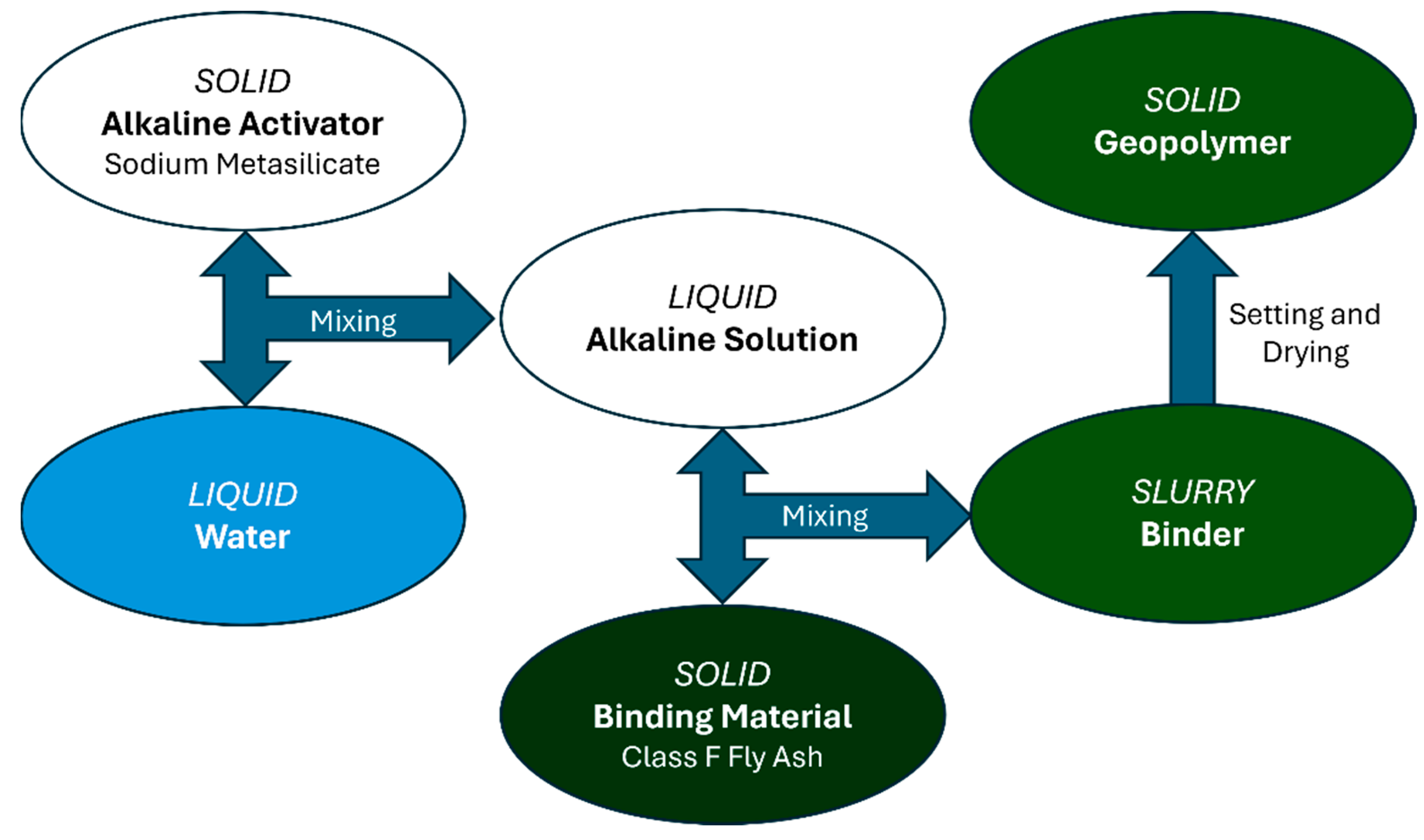

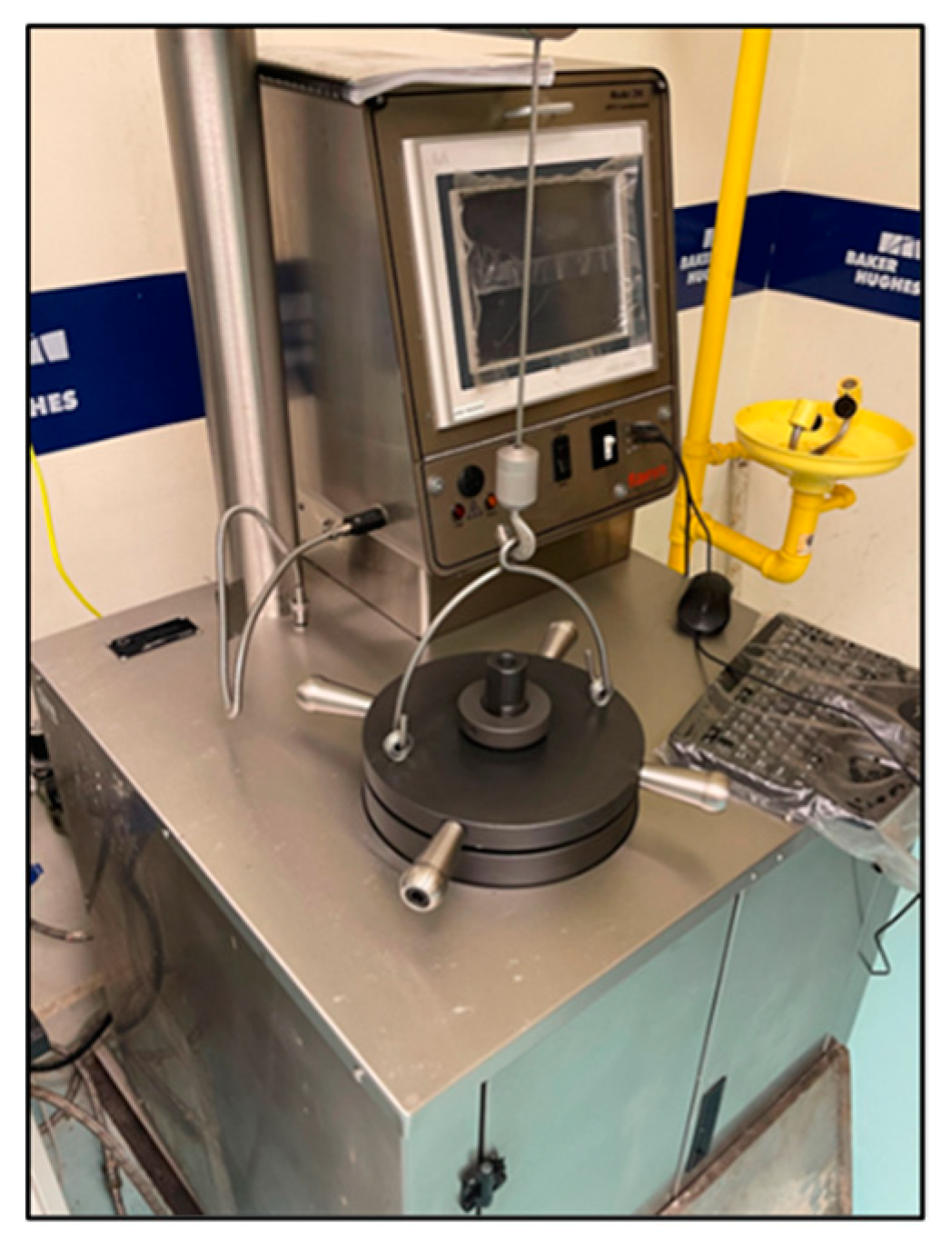
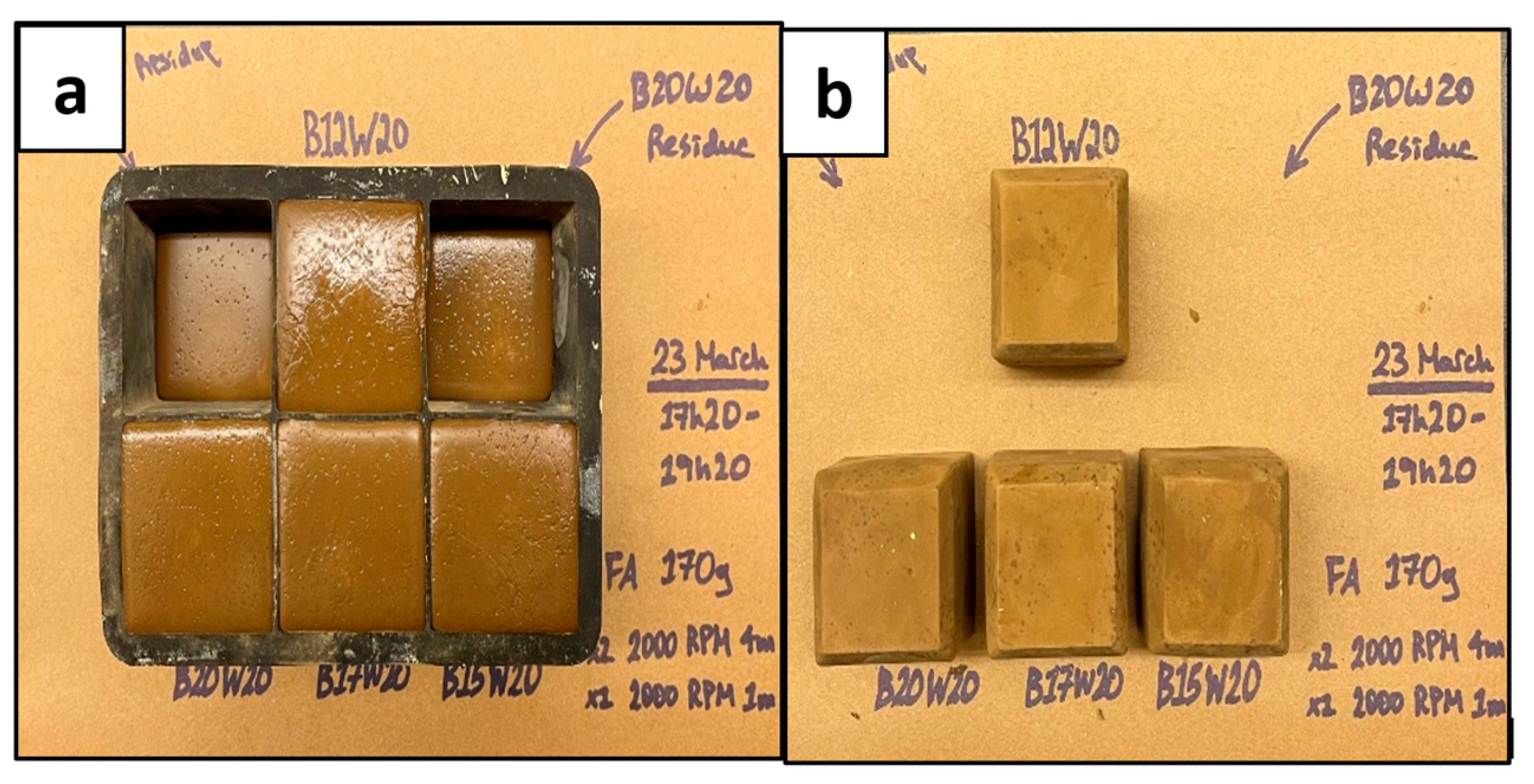
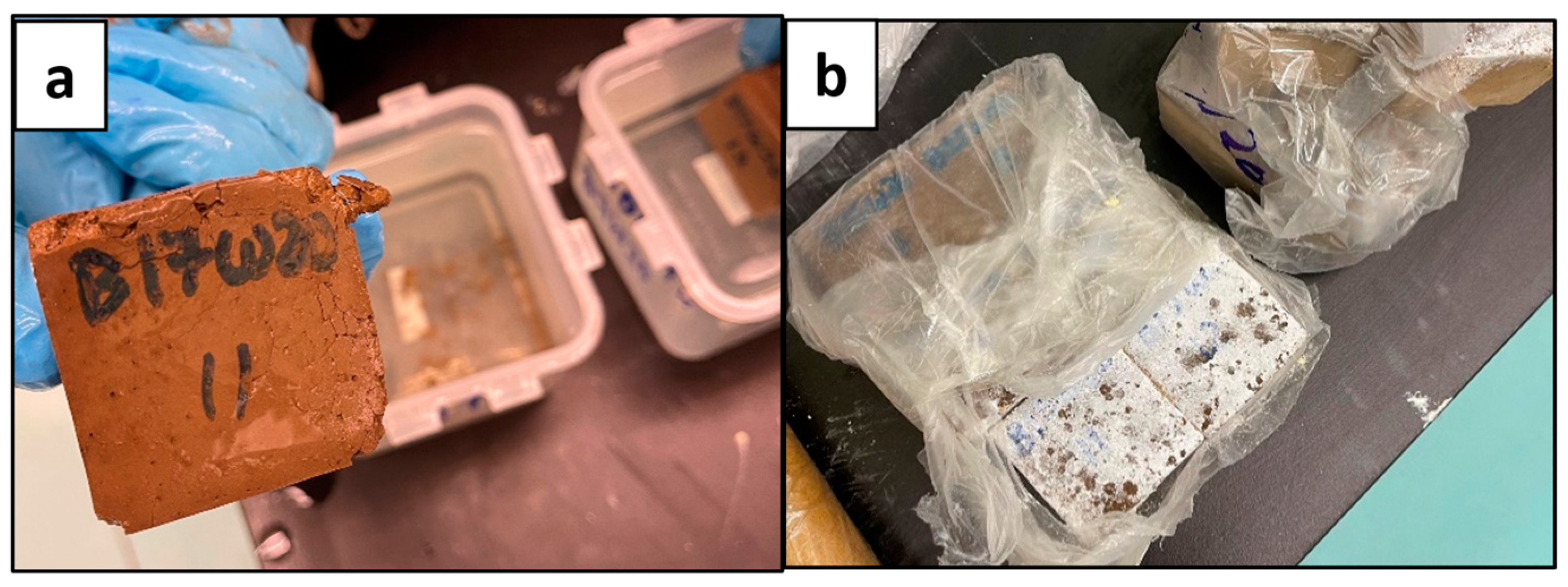

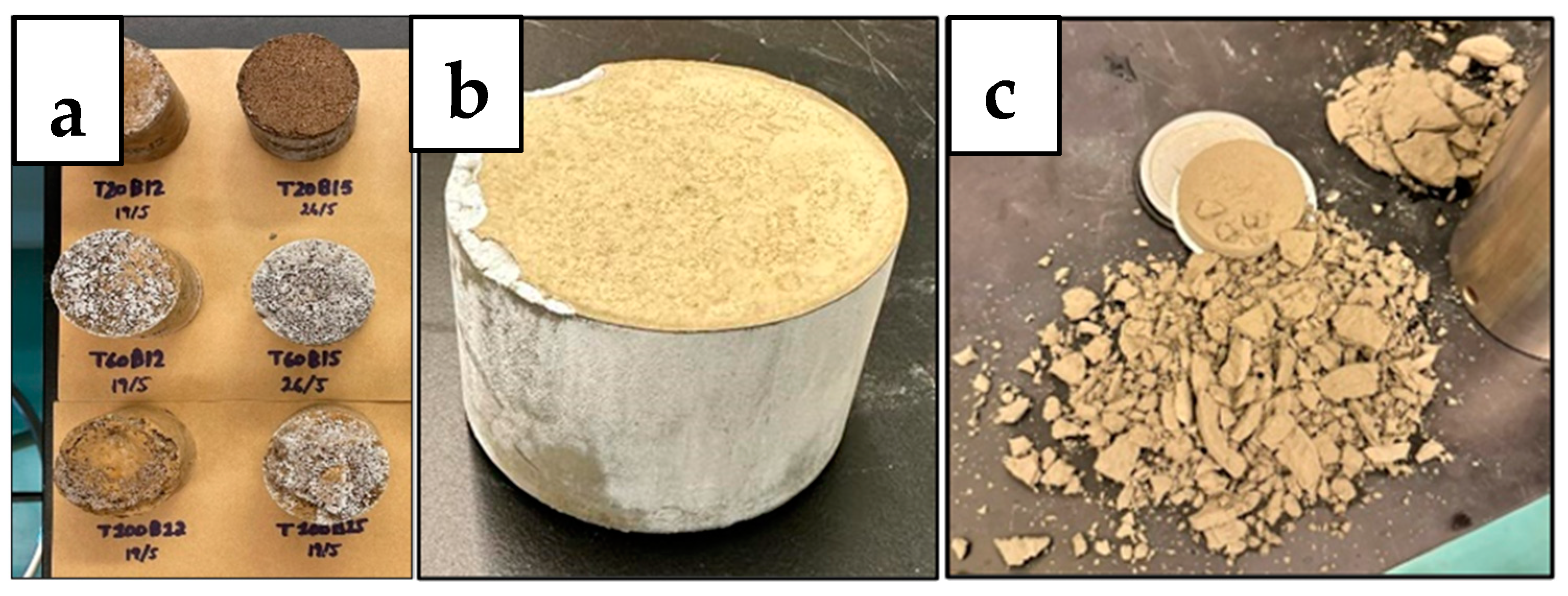
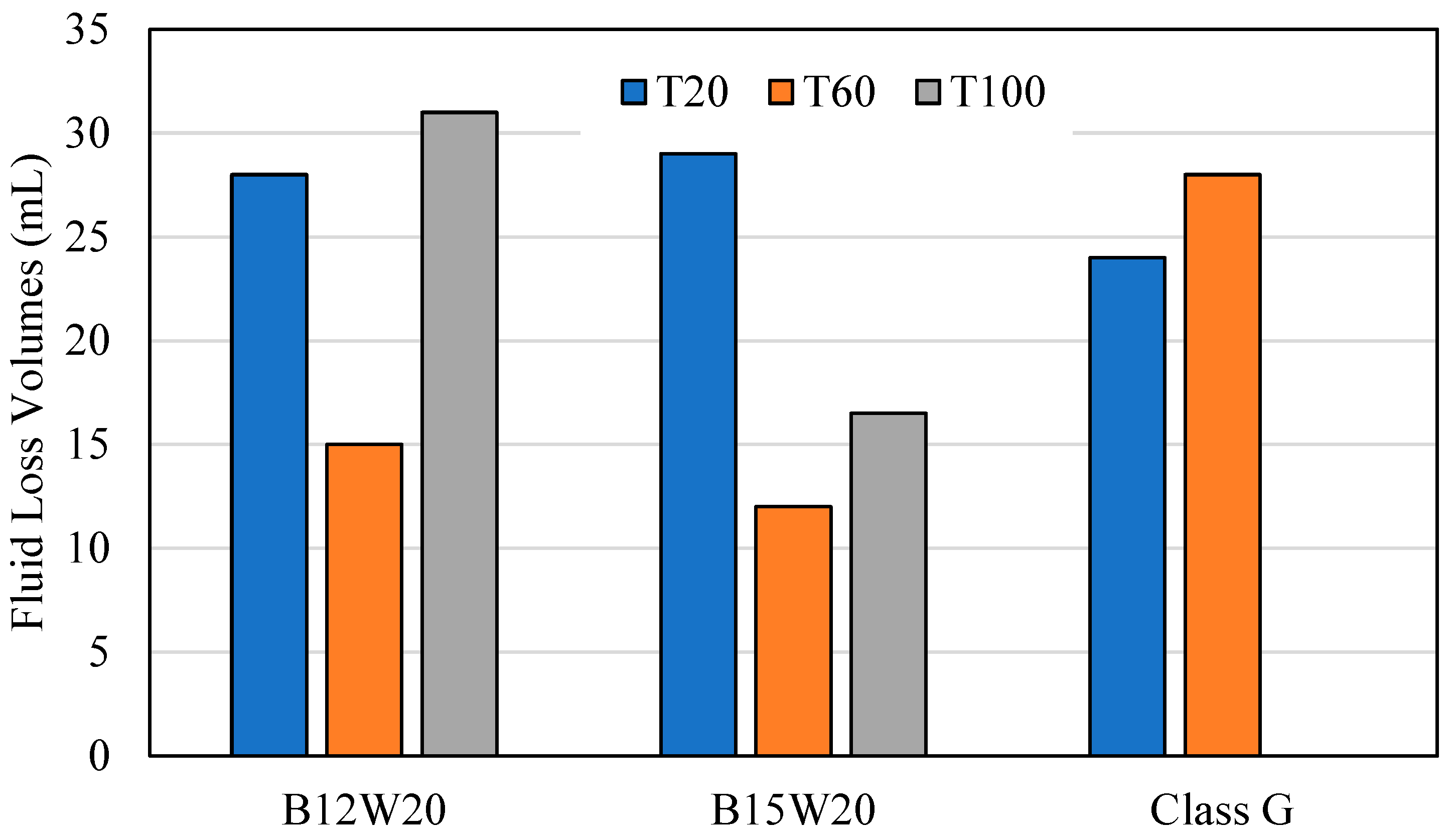

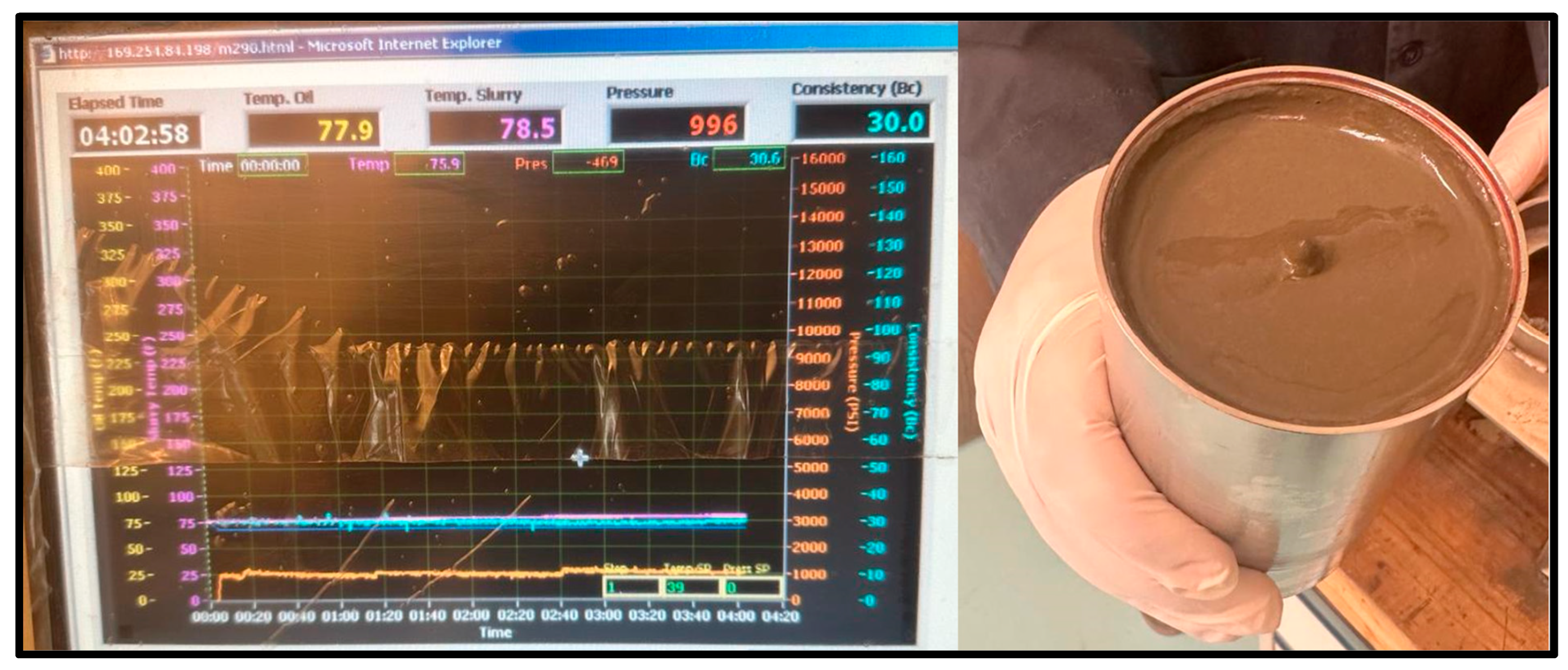
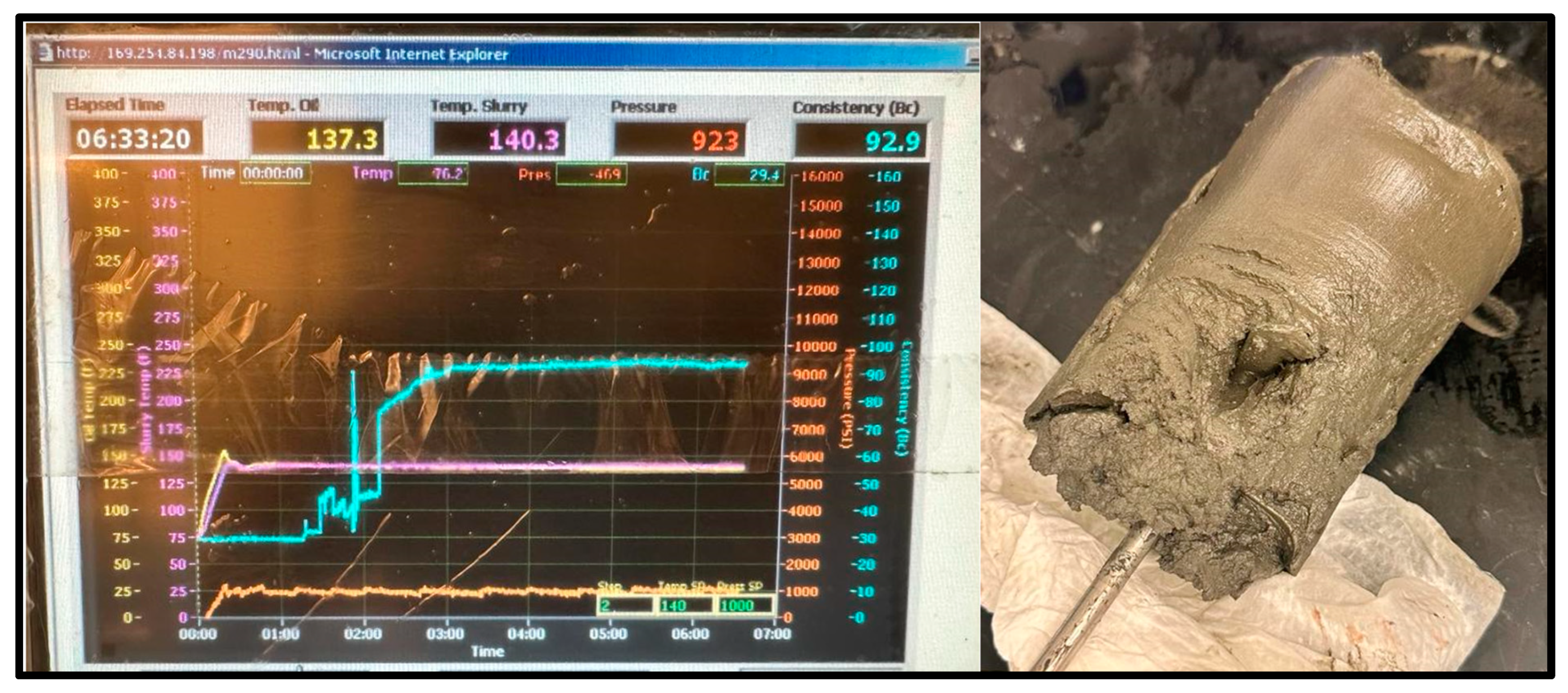
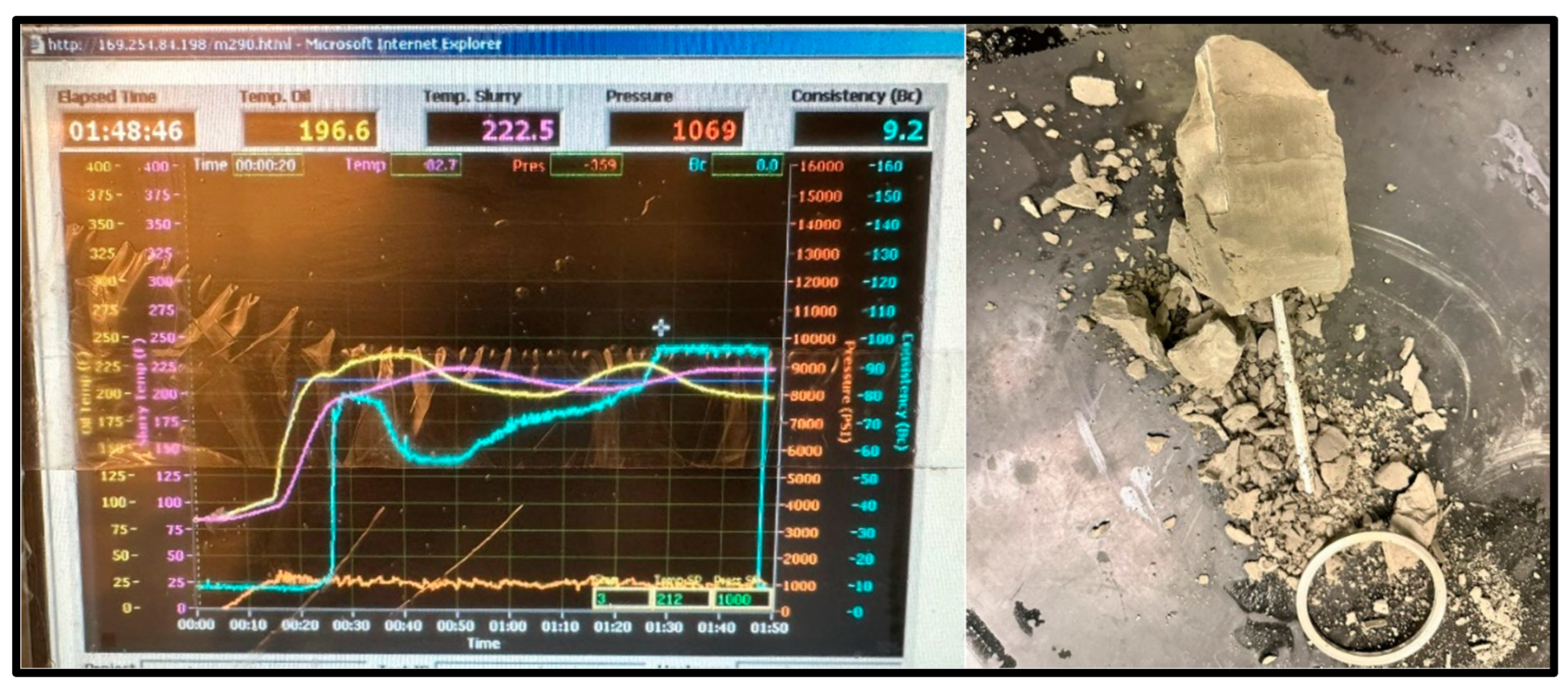
| Fly Ash Weight (g) | 170 | ||||||
| Fly Ash (g)/Binder (g) Ratio | 15 | 20 | 25 | 30 | 35 | ||
| Water Concentrations (%) | 10% | 15% | 20% | 25% | 30% | 35% | 40% |
| Fly Ash Weight (g) | 170 | ||||
| Fly Ash (g)/Binder (g) Ratio | 15 | 20 | 25 | 30 | 35 |
| Binder Weight (g) | 11.3 | 8.5 | 6.8 | 5.7 | 4.9 |
| Fly Ash Weight (g) | 170 | ||||
| Binder Concentrations (%) | 10 | 12 | 15 | 17 | 20 |
| Water Concentration (%) | 20% |
| Serial Number | FA/SS Ratio | Concentration (%) | Weight (g) | |||||
|---|---|---|---|---|---|---|---|---|
| Fly Ash | Sodium Metasilicate | Water | Fly Ash | Sodium Metasilicate | Water | Total | ||
| B10W20 | 7.0 | 70% | 10% | 20% | 170 | 24.29 | 48.57 | 243 |
| B12W20 | 5.7 | 68% | 12% | 20% | 170 | 30.00 | 50.00 | 250 |
| B15W20 | 4.3 | 65% | 15% | 20% | 170 | 39.23 | 52.31 | 262 |
| B17W20 | 3.7 | 63% | 17% | 20% | 170 | 45.87 | 53.97 | 270 |
| B20W20 | 3.0 | 60% | 20% | 20% | 170 | 56.67 | 56.67 | 283 |
Disclaimer/Publisher’s Note: The statements, opinions and data contained in all publications are solely those of the individual author(s) and contributor(s) and not of MDPI and/or the editor(s). MDPI and/or the editor(s) disclaim responsibility for any injury to people or property resulting from any ideas, methods, instructions or products referred to in the content. |
© 2024 by the authors. Licensee MDPI, Basel, Switzerland. This article is an open access article distributed under the terms and conditions of the Creative Commons Attribution (CC BY) license (https://creativecommons.org/licenses/by/4.0/).
Share and Cite
Helmy, Y.; Fakher, S. Evaluating the Performance of Class F Fly Ash Compared to Class G Cement for Hydrocarbon Wells Cementing: An Experimental Investigation. Materials 2024, 17, 2710. https://doi.org/10.3390/ma17112710
Helmy Y, Fakher S. Evaluating the Performance of Class F Fly Ash Compared to Class G Cement for Hydrocarbon Wells Cementing: An Experimental Investigation. Materials. 2024; 17(11):2710. https://doi.org/10.3390/ma17112710
Chicago/Turabian StyleHelmy, Youssef, and Sherif Fakher. 2024. "Evaluating the Performance of Class F Fly Ash Compared to Class G Cement for Hydrocarbon Wells Cementing: An Experimental Investigation" Materials 17, no. 11: 2710. https://doi.org/10.3390/ma17112710
APA StyleHelmy, Y., & Fakher, S. (2024). Evaluating the Performance of Class F Fly Ash Compared to Class G Cement for Hydrocarbon Wells Cementing: An Experimental Investigation. Materials, 17(11), 2710. https://doi.org/10.3390/ma17112710






